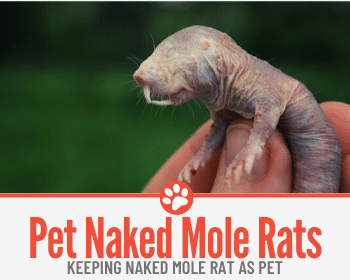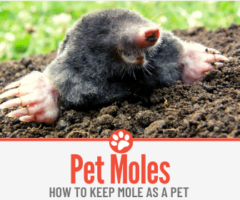 Naked mole rats require a lot of maintenance and care and this should be taken into account when deciding whether to keep one as a pet.
Naked mole rats require a lot of maintenance and care and this should be taken into account when deciding whether to keep one as a pet.
Here are some top tips to get the best from the situation
Keeping Naked Mole Rat as Pet
- Being very sociable, you won’t be taking just one naked mole rat home; you will need to cater for a huge family since naked mole rats live in large colonies, with a strong caste system.
- Big families need big homes, and one single tunnel is not enough. The environment will need to have multiple avenues for each within the hierarchy to have its rightful place and avoid aggression and stress.
- Check out their teeth and now consider how tough the material you make their home from needs to be. You don’t want to wake up one night with it sitting on your pillow.
- Keeping the temperature of the burrow equilibrated is very important, and if it is too hot or too cold for too long it can really be detrimental to the animals.
Here’s a little more about this unusual animal & what you can expect If you want to Keep naked mole rat as a Pet
Characteristics of Pet Naked Mole Rats
Naked mole rats are another type of burrowing rodent, and are also sometimes called sand puppies.
They are pretty small, only 8 to 10cm long, weighing about 30g. The dominant female, the queen, is larger, around 50g. The animal has no fur and cannot feel anything on its skin. This is probably an evolutionary precaution, developed to help it deal with the harsh surroundings it lives in, as well as the acidic carbon dioxide build-up in its body from living underground.
Naked mole rats are ectothermic; that is cold-blooded. Their bodies don’t expend energy in regulating or heating the body, instead they rely on getting heat from their surrounding environment. As a result, these rodents have very low metabolism and respiratory rates.
They also have an exceptional ability at keeping their body temperature between specific parameters, even when the surroundings are changing – they are thermoconformers. During winter or colder conditions, they will also huddle together or go deeper underground for warmth.
Visually, these are unusual-looking creatures. They have pink skin and massive front teeth. Although they have no fur, they do have whiskers to aid navigation, and hair between their toes, so that their feet can act as brooms to sweep up soil as they go along.
Habitat
Naked mole rats are commonly found in East Africa, in grassy, semi arid regions. They burrow massive expanses of tunnels that can reach up to 5km in length. Bear this in mind when you are laying out their living space in captivity.
Sense of sight, smell and hearing
Like moles, these animals have poor vision, but use their sense of smell and touch to navigate the world around them. They also use their teeth to sense their surroundings.
The teeth can work independently of each other, moving in different directions to help act as important extensions of their bodies.
Tunneling
Naked mole rats can move forwards and backwards easily, helping them maneuver busy, narrow tunnels. They dig with their teeth, which continually regenerate as they wear down.
Digging is typically done after the rainy season when the ground is softer.
The animals have massive power in their jaws, and lips close behind the teeth to stop soil getting into the mouth.
Eating habits And what to Feed your Pet Naked mole Rat
As herbivores, naked mole rats live on plants, primarily tubers found underground. Symbiotic bacteria are present in their guts to help digest the large quantity of cellulose they consume. They will even eat their own feces on occasion.
The reason for this, it is thought, is to share the hormones from the queen, as well as maximising nutrient absorption from their food.
Naked mole rats don’t drink water, but get the moisture they need from the plants in their diet.
In captivity, you will need to regularly replenish with fresh food, and remove any rotting waste.
Sociability and Behaviours
These are very sociable creatures, living in colonies of about 75 to 80 rodents. They are the only eusocial of all mammals (and so very unlike moles). This is a characteristic more common in bees and insects, in that naked mole rats will-
- Look after offspring of other moles
- Live together with multiple generations in the same colony
- Share labour, so much so that certain groups can lose the ability to do/behave in certain ways, resulting in a caste system.
In a burrow there will be the queen and other females and males. These lesser naked mole rats are segregated into a caste system, with each assigned specific tasks.
Some are workers, responsible for getting food and maintaining the tunnels; others are soldiers or dispersers. Dispersers actively seek other colonies to avoid heavy inbreeding. To help with the task, their body structure is slightly different to the rest, in that they have fat reserves to make the journeys to the other colonies.
Breeding
It is only the dominant female that reproduces; all other females are temporarily sterile. If she dies others fight to take her place.
Gestation lasts 70 days and on average 12 pups are born, although litters can be as large as 30.
Interaction with humans / Other
Naked mole rats are the longest living rodents in captivity, having been known to live to 32 years of age. They are also unusually resistant to cancer and can survive up to 18 minutes without oxygen – two traits that make for interesting research.






